Analyzing Staff Motivation Schemes Impact on Employee Retention
VerifiedAdded on 2023/06/15
|29
|6205
|450
Report
AI Summary
This report investigates the impact of staff motivation schemes on employee retention, focusing on Sainsbury, a leading retail organization. The research aims to identify the concept of talent management, assess the influence of staff motivation schemes on retaining employees, and determine the challenges Sainsbury might face in implementing these schemes. The methodology employs a quantitative research approach, utilizing surveys to gather data from a sample of 30 Sainsbury employees. The literature review highlights the importance of talent management in enhancing brand image, employee satisfaction, and long-term sustainability. It also addresses potential challenges such as low expectations and resistance to change, suggesting strategies like constant feedback and performance evaluation to overcome these obstacles. The study concludes that effective talent management, particularly through well-designed staff motivation schemes, is crucial for retaining employees and improving overall organizational performance, while acknowledging the need for continuous improvement and adaptation to address potential challenges.
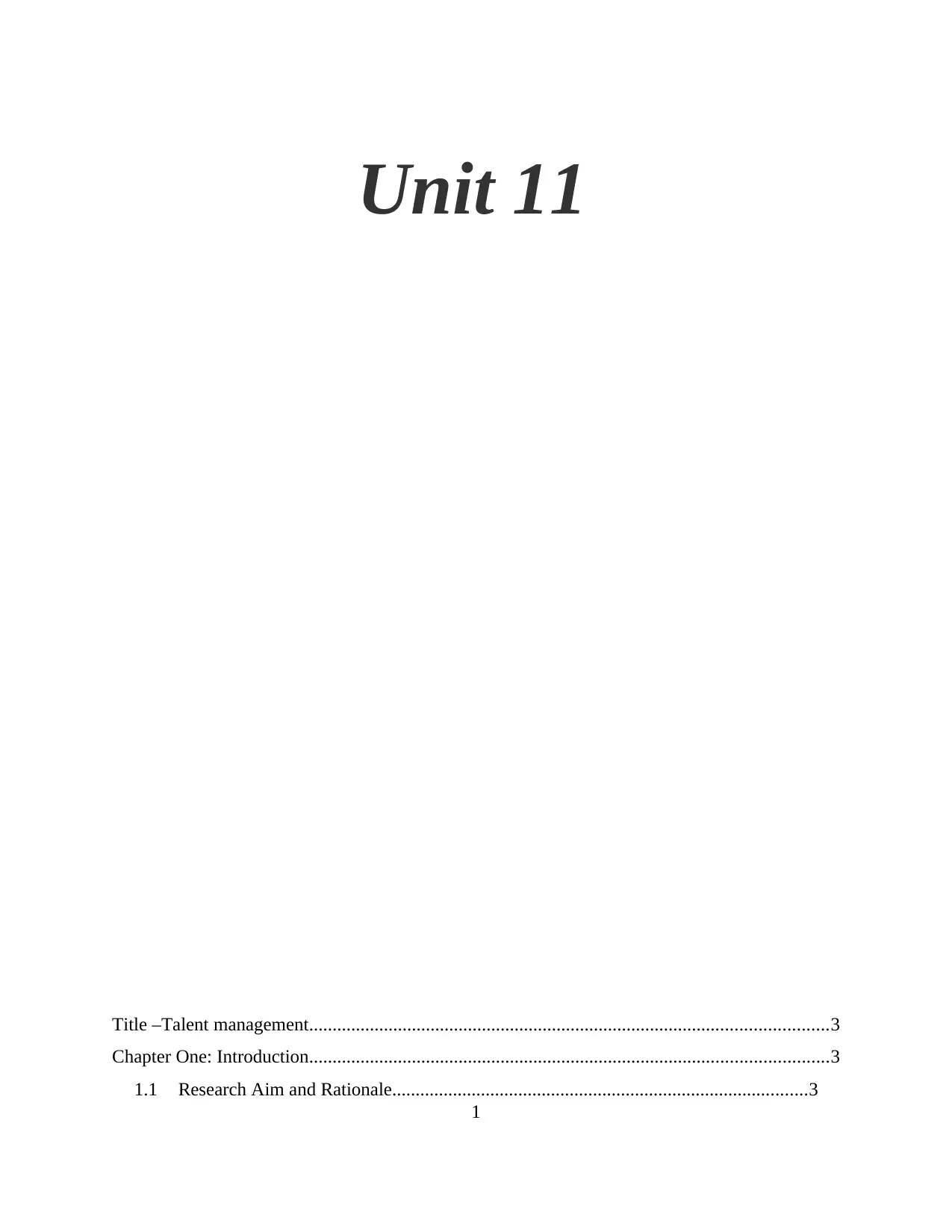
Unit 11
Title –Talent management...............................................................................................................3
Chapter One: Introduction...............................................................................................................3
1.1 Research Aim and Rationale.........................................................................................3
1
Title –Talent management...............................................................................................................3
Chapter One: Introduction...............................................................................................................3
1.1 Research Aim and Rationale.........................................................................................3
1
Paraphrase This Document
Need a fresh take? Get an instant paraphrase of this document with our AI Paraphraser
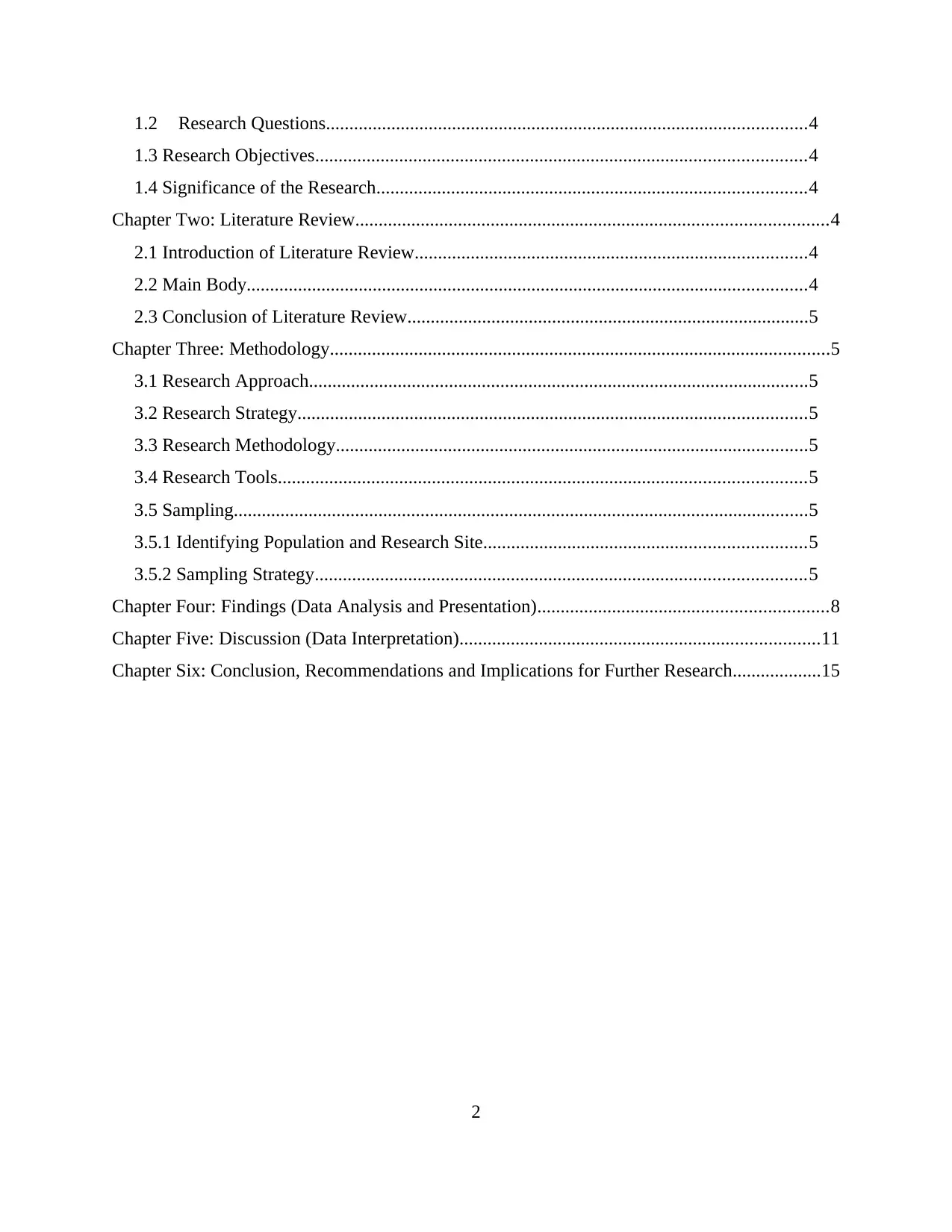
1.2 Research Questions.......................................................................................................4
1.3 Research Objectives.........................................................................................................4
1.4 Significance of the Research............................................................................................4
Chapter Two: Literature Review.....................................................................................................4
2.1 Introduction of Literature Review....................................................................................4
2.2 Main Body........................................................................................................................4
2.3 Conclusion of Literature Review......................................................................................5
Chapter Three: Methodology...........................................................................................................5
3.1 Research Approach...........................................................................................................5
3.2 Research Strategy.............................................................................................................5
3.3 Research Methodology.....................................................................................................5
3.4 Research Tools.................................................................................................................5
3.5 Sampling...........................................................................................................................5
3.5.1 Identifying Population and Research Site.....................................................................5
3.5.2 Sampling Strategy.........................................................................................................5
Chapter Four: Findings (Data Analysis and Presentation)..............................................................8
Chapter Five: Discussion (Data Interpretation).............................................................................11
Chapter Six: Conclusion, Recommendations and Implications for Further Research...................15
2
1.3 Research Objectives.........................................................................................................4
1.4 Significance of the Research............................................................................................4
Chapter Two: Literature Review.....................................................................................................4
2.1 Introduction of Literature Review....................................................................................4
2.2 Main Body........................................................................................................................4
2.3 Conclusion of Literature Review......................................................................................5
Chapter Three: Methodology...........................................................................................................5
3.1 Research Approach...........................................................................................................5
3.2 Research Strategy.............................................................................................................5
3.3 Research Methodology.....................................................................................................5
3.4 Research Tools.................................................................................................................5
3.5 Sampling...........................................................................................................................5
3.5.1 Identifying Population and Research Site.....................................................................5
3.5.2 Sampling Strategy.........................................................................................................5
Chapter Four: Findings (Data Analysis and Presentation)..............................................................8
Chapter Five: Discussion (Data Interpretation).............................................................................11
Chapter Six: Conclusion, Recommendations and Implications for Further Research...................15
2
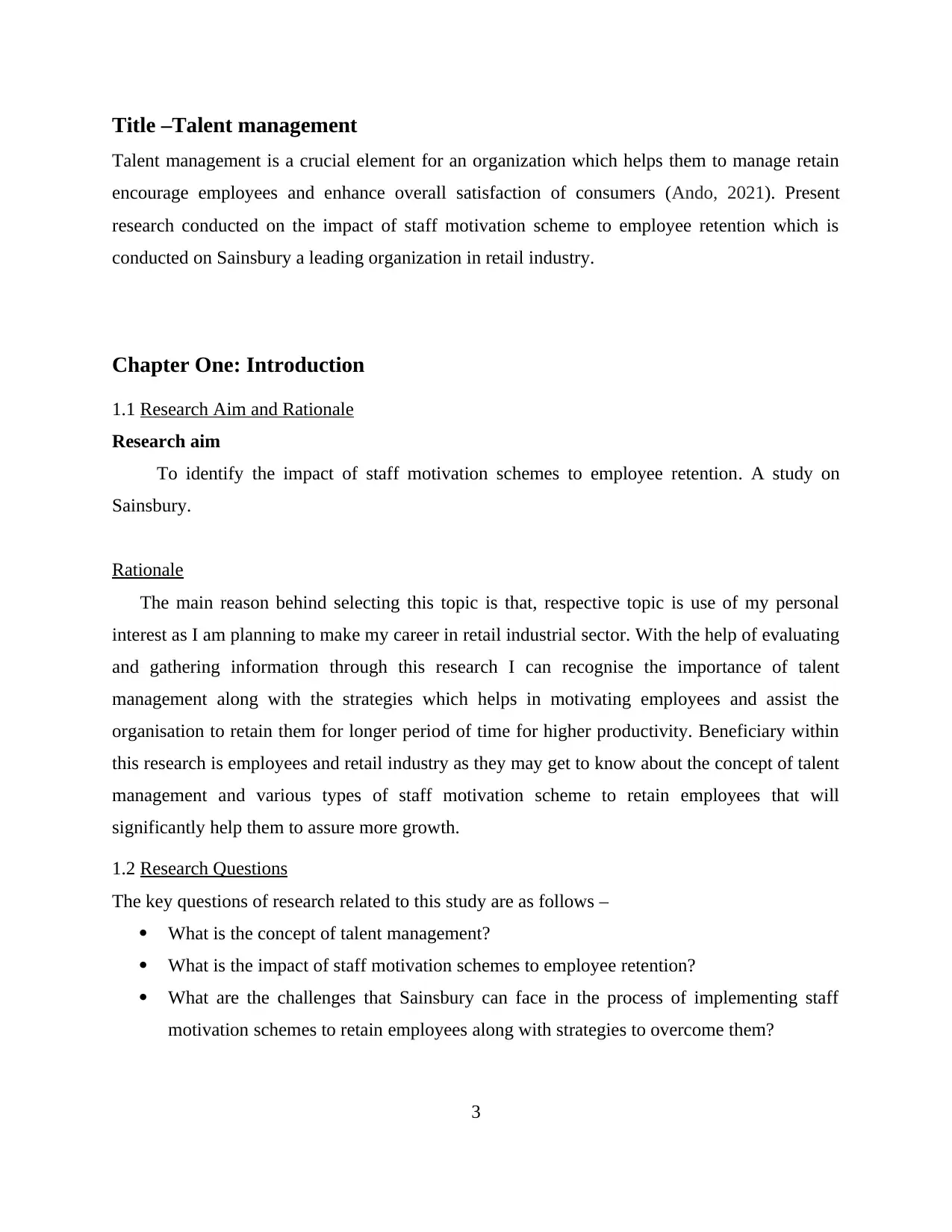
Title –Talent management
Talent management is a crucial element for an organization which helps them to manage retain
encourage employees and enhance overall satisfaction of consumers (Ando, 2021). Present
research conducted on the impact of staff motivation scheme to employee retention which is
conducted on Sainsbury a leading organization in retail industry.
Chapter One: Introduction
1.1 Research Aim and Rationale
Research aim
To identify the impact of staff motivation schemes to employee retention. A study on
Sainsbury.
Rationale
The main reason behind selecting this topic is that, respective topic is use of my personal
interest as I am planning to make my career in retail industrial sector. With the help of evaluating
and gathering information through this research I can recognise the importance of talent
management along with the strategies which helps in motivating employees and assist the
organisation to retain them for longer period of time for higher productivity. Beneficiary within
this research is employees and retail industry as they may get to know about the concept of talent
management and various types of staff motivation scheme to retain employees that will
significantly help them to assure more growth.
1.2 Research Questions
The key questions of research related to this study are as follows –
What is the concept of talent management?
What is the impact of staff motivation schemes to employee retention?
What are the challenges that Sainsbury can face in the process of implementing staff
motivation schemes to retain employees along with strategies to overcome them?
3
Talent management is a crucial element for an organization which helps them to manage retain
encourage employees and enhance overall satisfaction of consumers (Ando, 2021). Present
research conducted on the impact of staff motivation scheme to employee retention which is
conducted on Sainsbury a leading organization in retail industry.
Chapter One: Introduction
1.1 Research Aim and Rationale
Research aim
To identify the impact of staff motivation schemes to employee retention. A study on
Sainsbury.
Rationale
The main reason behind selecting this topic is that, respective topic is use of my personal
interest as I am planning to make my career in retail industrial sector. With the help of evaluating
and gathering information through this research I can recognise the importance of talent
management along with the strategies which helps in motivating employees and assist the
organisation to retain them for longer period of time for higher productivity. Beneficiary within
this research is employees and retail industry as they may get to know about the concept of talent
management and various types of staff motivation scheme to retain employees that will
significantly help them to assure more growth.
1.2 Research Questions
The key questions of research related to this study are as follows –
What is the concept of talent management?
What is the impact of staff motivation schemes to employee retention?
What are the challenges that Sainsbury can face in the process of implementing staff
motivation schemes to retain employees along with strategies to overcome them?
3
⊘ This is a preview!⊘
Do you want full access?
Subscribe today to unlock all pages.

Trusted by 1+ million students worldwide
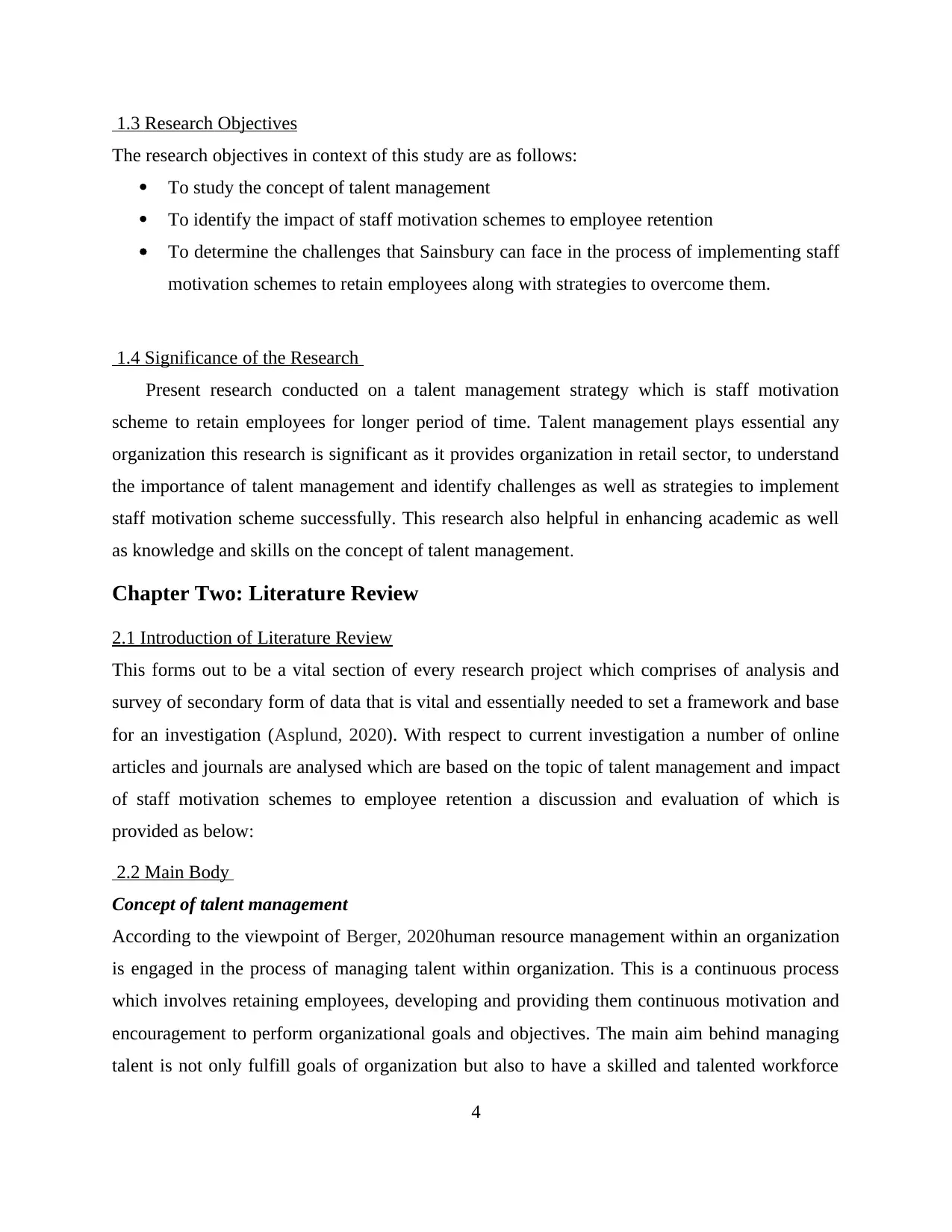
1.3 Research Objectives
The research objectives in context of this study are as follows:
To study the concept of talent management
To identify the impact of staff motivation schemes to employee retention
To determine the challenges that Sainsbury can face in the process of implementing staff
motivation schemes to retain employees along with strategies to overcome them.
1.4 Significance of the Research
Present research conducted on a talent management strategy which is staff motivation
scheme to retain employees for longer period of time. Talent management plays essential any
organization this research is significant as it provides organization in retail sector, to understand
the importance of talent management and identify challenges as well as strategies to implement
staff motivation scheme successfully. This research also helpful in enhancing academic as well
as knowledge and skills on the concept of talent management.
Chapter Two: Literature Review
2.1 Introduction of Literature Review
This forms out to be a vital section of every research project which comprises of analysis and
survey of secondary form of data that is vital and essentially needed to set a framework and base
for an investigation (Asplund, 2020). With respect to current investigation a number of online
articles and journals are analysed which are based on the topic of talent management and impact
of staff motivation schemes to employee retention a discussion and evaluation of which is
provided as below:
2.2 Main Body
Concept of talent management
According to the viewpoint of Berger, 2020human resource management within an organization
is engaged in the process of managing talent within organization. This is a continuous process
which involves retaining employees, developing and providing them continuous motivation and
encouragement to perform organizational goals and objectives. The main aim behind managing
talent is not only fulfill goals of organization but also to have a skilled and talented workforce
4
The research objectives in context of this study are as follows:
To study the concept of talent management
To identify the impact of staff motivation schemes to employee retention
To determine the challenges that Sainsbury can face in the process of implementing staff
motivation schemes to retain employees along with strategies to overcome them.
1.4 Significance of the Research
Present research conducted on a talent management strategy which is staff motivation
scheme to retain employees for longer period of time. Talent management plays essential any
organization this research is significant as it provides organization in retail sector, to understand
the importance of talent management and identify challenges as well as strategies to implement
staff motivation scheme successfully. This research also helpful in enhancing academic as well
as knowledge and skills on the concept of talent management.
Chapter Two: Literature Review
2.1 Introduction of Literature Review
This forms out to be a vital section of every research project which comprises of analysis and
survey of secondary form of data that is vital and essentially needed to set a framework and base
for an investigation (Asplund, 2020). With respect to current investigation a number of online
articles and journals are analysed which are based on the topic of talent management and impact
of staff motivation schemes to employee retention a discussion and evaluation of which is
provided as below:
2.2 Main Body
Concept of talent management
According to the viewpoint of Berger, 2020human resource management within an organization
is engaged in the process of managing talent within organization. This is a continuous process
which involves retaining employees, developing and providing them continuous motivation and
encouragement to perform organizational goals and objectives. The main aim behind managing
talent is not only fulfill goals of organization but also to have a skilled and talented workforce
4
Paraphrase This Document
Need a fresh take? Get an instant paraphrase of this document with our AI Paraphraser
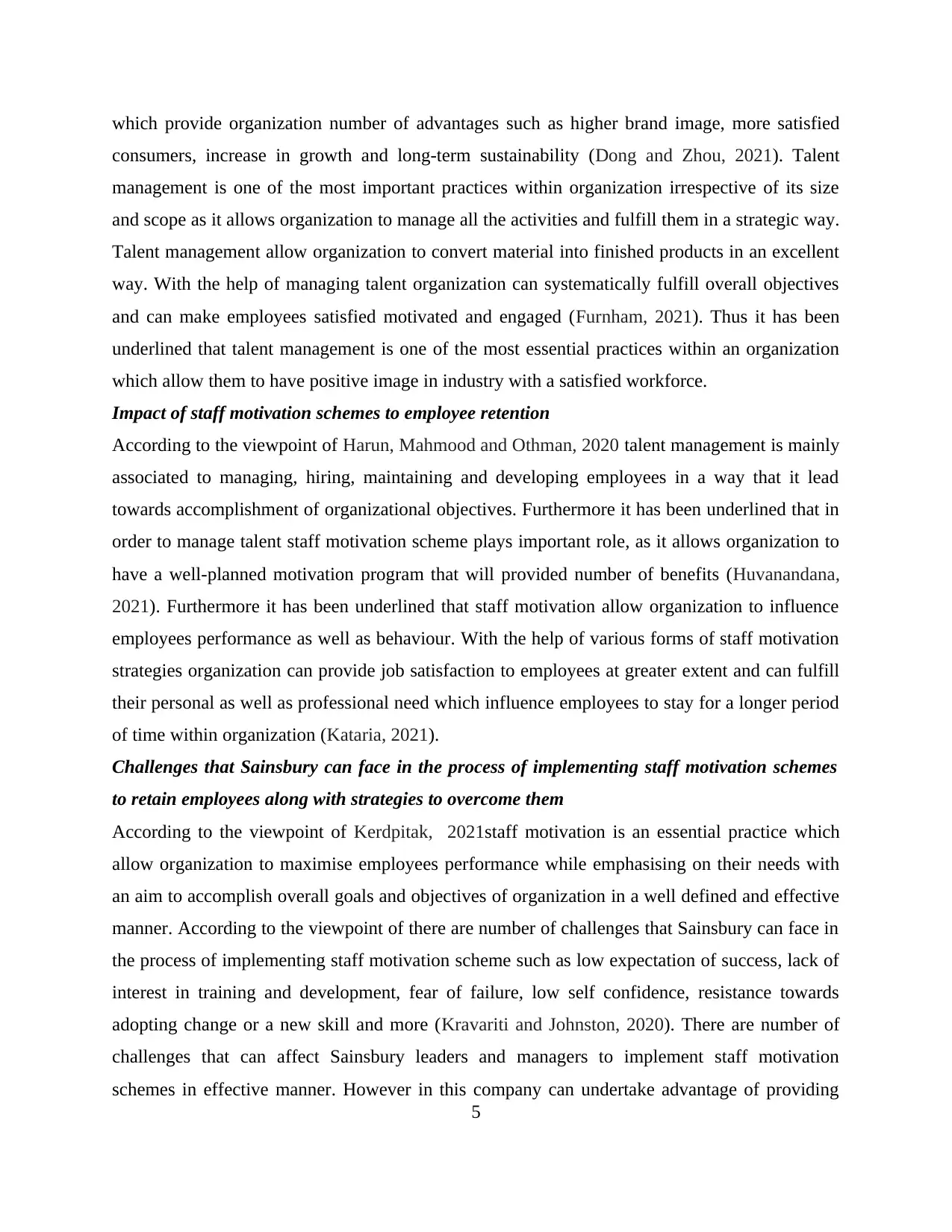
which provide organization number of advantages such as higher brand image, more satisfied
consumers, increase in growth and long-term sustainability (Dong and Zhou, 2021). Talent
management is one of the most important practices within organization irrespective of its size
and scope as it allows organization to manage all the activities and fulfill them in a strategic way.
Talent management allow organization to convert material into finished products in an excellent
way. With the help of managing talent organization can systematically fulfill overall objectives
and can make employees satisfied motivated and engaged (Furnham, 2021). Thus it has been
underlined that talent management is one of the most essential practices within an organization
which allow them to have positive image in industry with a satisfied workforce.
Impact of staff motivation schemes to employee retention
According to the viewpoint of Harun, Mahmood and Othman, 2020 talent management is mainly
associated to managing, hiring, maintaining and developing employees in a way that it lead
towards accomplishment of organizational objectives. Furthermore it has been underlined that in
order to manage talent staff motivation scheme plays important role, as it allows organization to
have a well-planned motivation program that will provided number of benefits (Huvanandana,
2021). Furthermore it has been underlined that staff motivation allow organization to influence
employees performance as well as behaviour. With the help of various forms of staff motivation
strategies organization can provide job satisfaction to employees at greater extent and can fulfill
their personal as well as professional need which influence employees to stay for a longer period
of time within organization (Kataria, 2021).
Challenges that Sainsbury can face in the process of implementing staff motivation schemes
to retain employees along with strategies to overcome them
According to the viewpoint of Kerdpitak, 2021staff motivation is an essential practice which
allow organization to maximise employees performance while emphasising on their needs with
an aim to accomplish overall goals and objectives of organization in a well defined and effective
manner. According to the viewpoint of there are number of challenges that Sainsbury can face in
the process of implementing staff motivation scheme such as low expectation of success, lack of
interest in training and development, fear of failure, low self confidence, resistance towards
adopting change or a new skill and more (Kravariti and Johnston, 2020). There are number of
challenges that can affect Sainsbury leaders and managers to implement staff motivation
schemes in effective manner. However in this company can undertake advantage of providing
5
consumers, increase in growth and long-term sustainability (Dong and Zhou, 2021). Talent
management is one of the most important practices within organization irrespective of its size
and scope as it allows organization to manage all the activities and fulfill them in a strategic way.
Talent management allow organization to convert material into finished products in an excellent
way. With the help of managing talent organization can systematically fulfill overall objectives
and can make employees satisfied motivated and engaged (Furnham, 2021). Thus it has been
underlined that talent management is one of the most essential practices within an organization
which allow them to have positive image in industry with a satisfied workforce.
Impact of staff motivation schemes to employee retention
According to the viewpoint of Harun, Mahmood and Othman, 2020 talent management is mainly
associated to managing, hiring, maintaining and developing employees in a way that it lead
towards accomplishment of organizational objectives. Furthermore it has been underlined that in
order to manage talent staff motivation scheme plays important role, as it allows organization to
have a well-planned motivation program that will provided number of benefits (Huvanandana,
2021). Furthermore it has been underlined that staff motivation allow organization to influence
employees performance as well as behaviour. With the help of various forms of staff motivation
strategies organization can provide job satisfaction to employees at greater extent and can fulfill
their personal as well as professional need which influence employees to stay for a longer period
of time within organization (Kataria, 2021).
Challenges that Sainsbury can face in the process of implementing staff motivation schemes
to retain employees along with strategies to overcome them
According to the viewpoint of Kerdpitak, 2021staff motivation is an essential practice which
allow organization to maximise employees performance while emphasising on their needs with
an aim to accomplish overall goals and objectives of organization in a well defined and effective
manner. According to the viewpoint of there are number of challenges that Sainsbury can face in
the process of implementing staff motivation scheme such as low expectation of success, lack of
interest in training and development, fear of failure, low self confidence, resistance towards
adopting change or a new skill and more (Kravariti and Johnston, 2020). There are number of
challenges that can affect Sainsbury leaders and managers to implement staff motivation
schemes in effective manner. However in this company can undertake advantage of providing
5
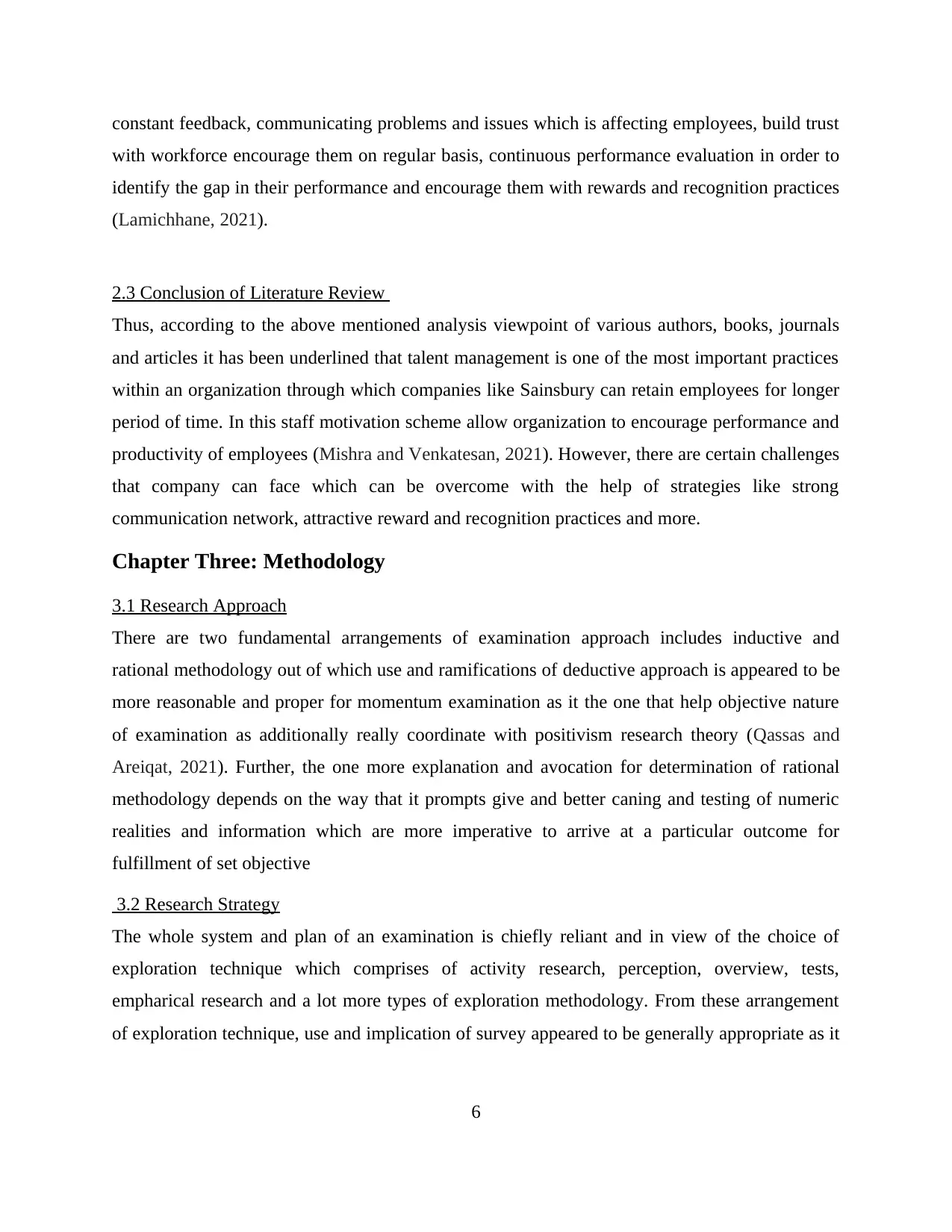
constant feedback, communicating problems and issues which is affecting employees, build trust
with workforce encourage them on regular basis, continuous performance evaluation in order to
identify the gap in their performance and encourage them with rewards and recognition practices
(Lamichhane, 2021).
2.3 Conclusion of Literature Review
Thus, according to the above mentioned analysis viewpoint of various authors, books, journals
and articles it has been underlined that talent management is one of the most important practices
within an organization through which companies like Sainsbury can retain employees for longer
period of time. In this staff motivation scheme allow organization to encourage performance and
productivity of employees (Mishra and Venkatesan, 2021). However, there are certain challenges
that company can face which can be overcome with the help of strategies like strong
communication network, attractive reward and recognition practices and more.
Chapter Three: Methodology
3.1 Research Approach
There are two fundamental arrangements of examination approach includes inductive and
rational methodology out of which use and ramifications of deductive approach is appeared to be
more reasonable and proper for momentum examination as it the one that help objective nature
of examination as additionally really coordinate with positivism research theory (Qassas and
Areiqat, 2021). Further, the one more explanation and avocation for determination of rational
methodology depends on the way that it prompts give and better caning and testing of numeric
realities and information which are more imperative to arrive at a particular outcome for
fulfillment of set objective
3.2 Research Strategy
The whole system and plan of an examination is chiefly reliant and in view of the choice of
exploration technique which comprises of activity research, perception, overview, tests,
empharical research and a lot more types of exploration methodology. From these arrangement
of exploration technique, use and implication of survey appeared to be generally appropriate as it
6
with workforce encourage them on regular basis, continuous performance evaluation in order to
identify the gap in their performance and encourage them with rewards and recognition practices
(Lamichhane, 2021).
2.3 Conclusion of Literature Review
Thus, according to the above mentioned analysis viewpoint of various authors, books, journals
and articles it has been underlined that talent management is one of the most important practices
within an organization through which companies like Sainsbury can retain employees for longer
period of time. In this staff motivation scheme allow organization to encourage performance and
productivity of employees (Mishra and Venkatesan, 2021). However, there are certain challenges
that company can face which can be overcome with the help of strategies like strong
communication network, attractive reward and recognition practices and more.
Chapter Three: Methodology
3.1 Research Approach
There are two fundamental arrangements of examination approach includes inductive and
rational methodology out of which use and ramifications of deductive approach is appeared to be
more reasonable and proper for momentum examination as it the one that help objective nature
of examination as additionally really coordinate with positivism research theory (Qassas and
Areiqat, 2021). Further, the one more explanation and avocation for determination of rational
methodology depends on the way that it prompts give and better caning and testing of numeric
realities and information which are more imperative to arrive at a particular outcome for
fulfillment of set objective
3.2 Research Strategy
The whole system and plan of an examination is chiefly reliant and in view of the choice of
exploration technique which comprises of activity research, perception, overview, tests,
empharical research and a lot more types of exploration methodology. From these arrangement
of exploration technique, use and implication of survey appeared to be generally appropriate as it
6
⊘ This is a preview!⊘
Do you want full access?
Subscribe today to unlock all pages.

Trusted by 1+ million students worldwide
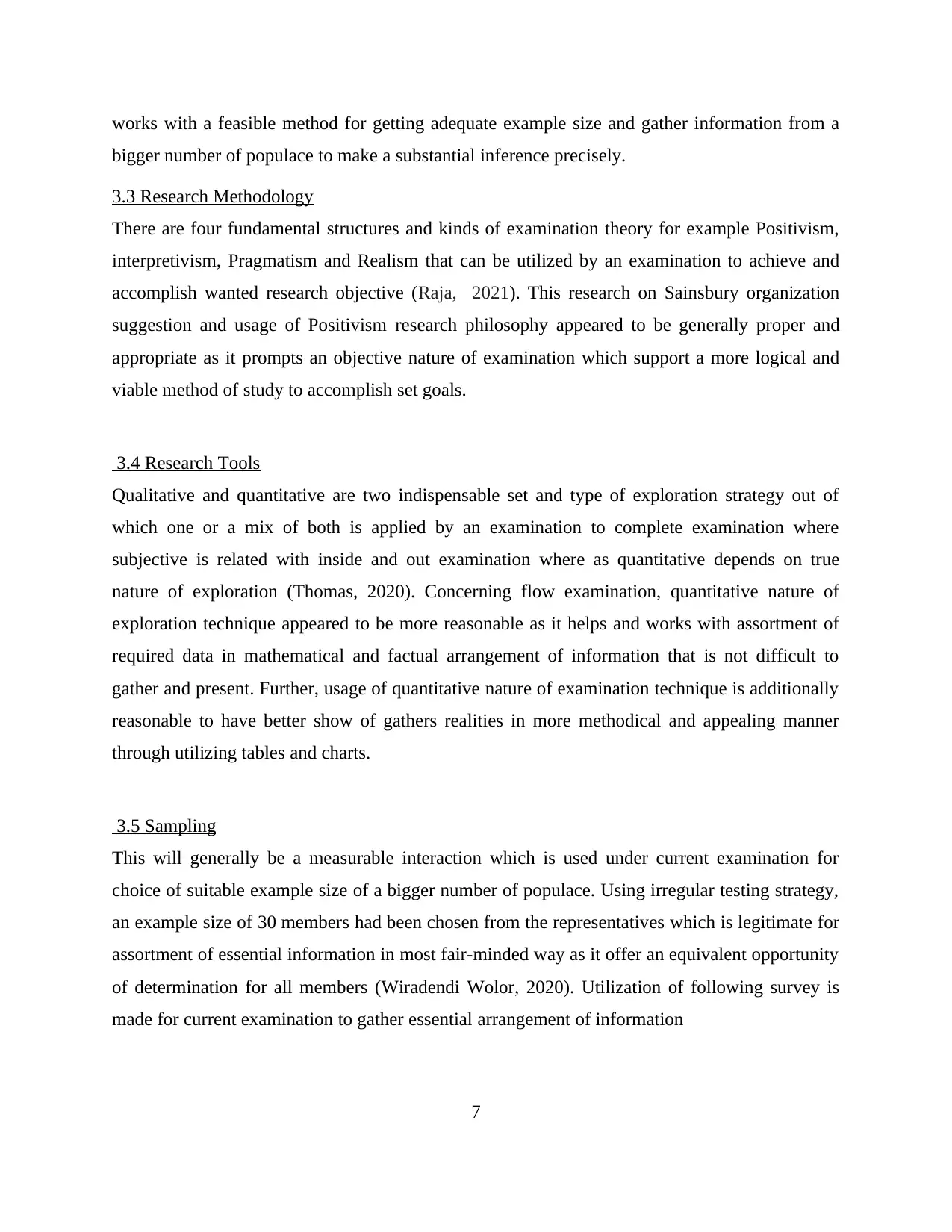
works with a feasible method for getting adequate example size and gather information from a
bigger number of populace to make a substantial inference precisely.
3.3 Research Methodology
There are four fundamental structures and kinds of examination theory for example Positivism,
interpretivism, Pragmatism and Realism that can be utilized by an examination to achieve and
accomplish wanted research objective (Raja, 2021). This research on Sainsbury organization
suggestion and usage of Positivism research philosophy appeared to be generally proper and
appropriate as it prompts an objective nature of examination which support a more logical and
viable method of study to accomplish set goals.
3.4 Research Tools
Qualitative and quantitative are two indispensable set and type of exploration strategy out of
which one or a mix of both is applied by an examination to complete examination where
subjective is related with inside and out examination where as quantitative depends on true
nature of exploration (Thomas, 2020). Concerning flow examination, quantitative nature of
exploration technique appeared to be more reasonable as it helps and works with assortment of
required data in mathematical and factual arrangement of information that is not difficult to
gather and present. Further, usage of quantitative nature of examination technique is additionally
reasonable to have better show of gathers realities in more methodical and appealing manner
through utilizing tables and charts.
3.5 Sampling
This will generally be a measurable interaction which is used under current examination for
choice of suitable example size of a bigger number of populace. Using irregular testing strategy,
an example size of 30 members had been chosen from the representatives which is legitimate for
assortment of essential information in most fair-minded way as it offer an equivalent opportunity
of determination for all members (Wiradendi Wolor, 2020). Utilization of following survey is
made for current examination to gather essential arrangement of information
7
bigger number of populace to make a substantial inference precisely.
3.3 Research Methodology
There are four fundamental structures and kinds of examination theory for example Positivism,
interpretivism, Pragmatism and Realism that can be utilized by an examination to achieve and
accomplish wanted research objective (Raja, 2021). This research on Sainsbury organization
suggestion and usage of Positivism research philosophy appeared to be generally proper and
appropriate as it prompts an objective nature of examination which support a more logical and
viable method of study to accomplish set goals.
3.4 Research Tools
Qualitative and quantitative are two indispensable set and type of exploration strategy out of
which one or a mix of both is applied by an examination to complete examination where
subjective is related with inside and out examination where as quantitative depends on true
nature of exploration (Thomas, 2020). Concerning flow examination, quantitative nature of
exploration technique appeared to be more reasonable as it helps and works with assortment of
required data in mathematical and factual arrangement of information that is not difficult to
gather and present. Further, usage of quantitative nature of examination technique is additionally
reasonable to have better show of gathers realities in more methodical and appealing manner
through utilizing tables and charts.
3.5 Sampling
This will generally be a measurable interaction which is used under current examination for
choice of suitable example size of a bigger number of populace. Using irregular testing strategy,
an example size of 30 members had been chosen from the representatives which is legitimate for
assortment of essential information in most fair-minded way as it offer an equivalent opportunity
of determination for all members (Wiradendi Wolor, 2020). Utilization of following survey is
made for current examination to gather essential arrangement of information
7
Paraphrase This Document
Need a fresh take? Get an instant paraphrase of this document with our AI Paraphraser
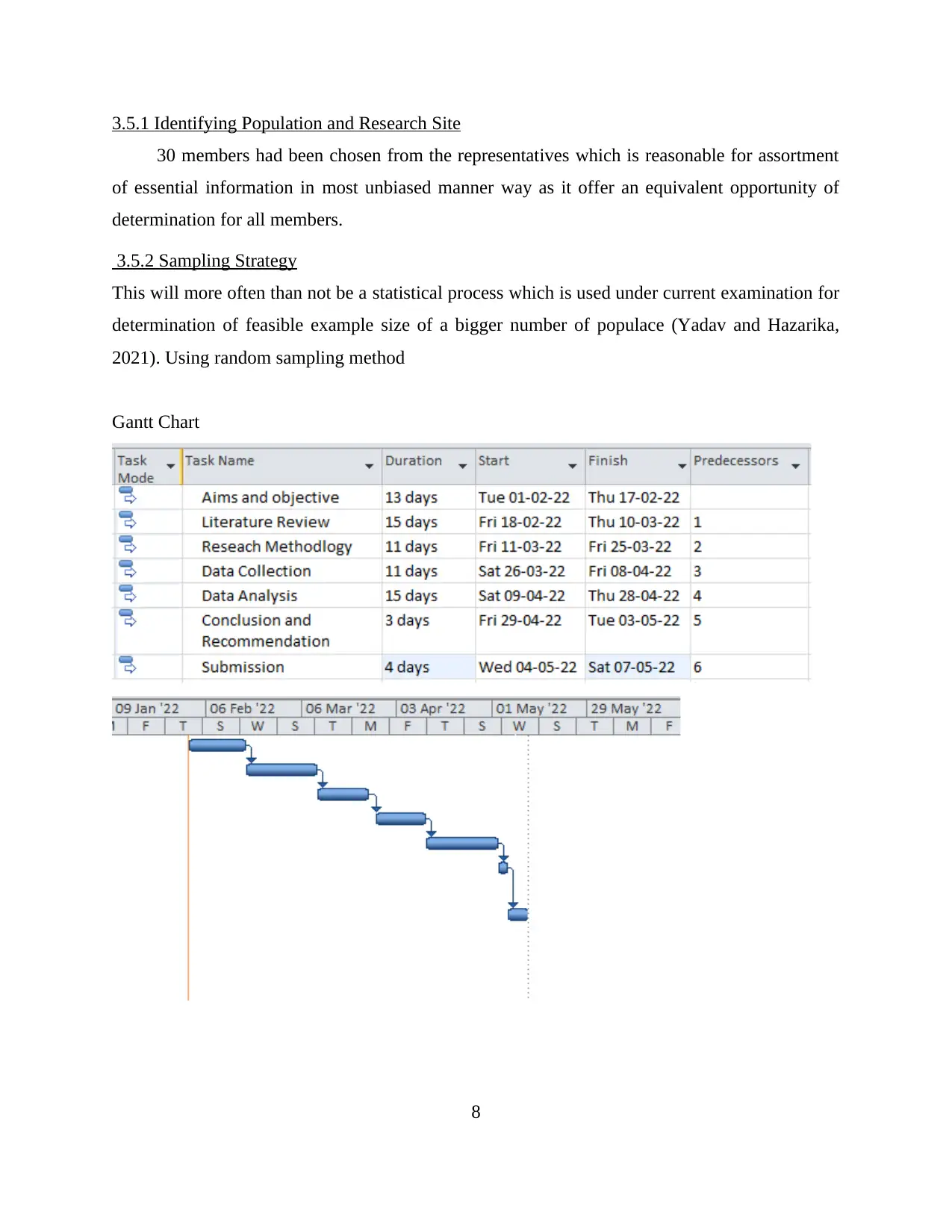
3.5.1 Identifying Population and Research Site
30 members had been chosen from the representatives which is reasonable for assortment
of essential information in most unbiased manner way as it offer an equivalent opportunity of
determination for all members.
3.5.2 Sampling Strategy
This will more often than not be a statistical process which is used under current examination for
determination of feasible example size of a bigger number of populace (Yadav and Hazarika,
2021). Using random sampling method
Gantt Chart
8
30 members had been chosen from the representatives which is reasonable for assortment
of essential information in most unbiased manner way as it offer an equivalent opportunity of
determination for all members.
3.5.2 Sampling Strategy
This will more often than not be a statistical process which is used under current examination for
determination of feasible example size of a bigger number of populace (Yadav and Hazarika,
2021). Using random sampling method
Gantt Chart
8
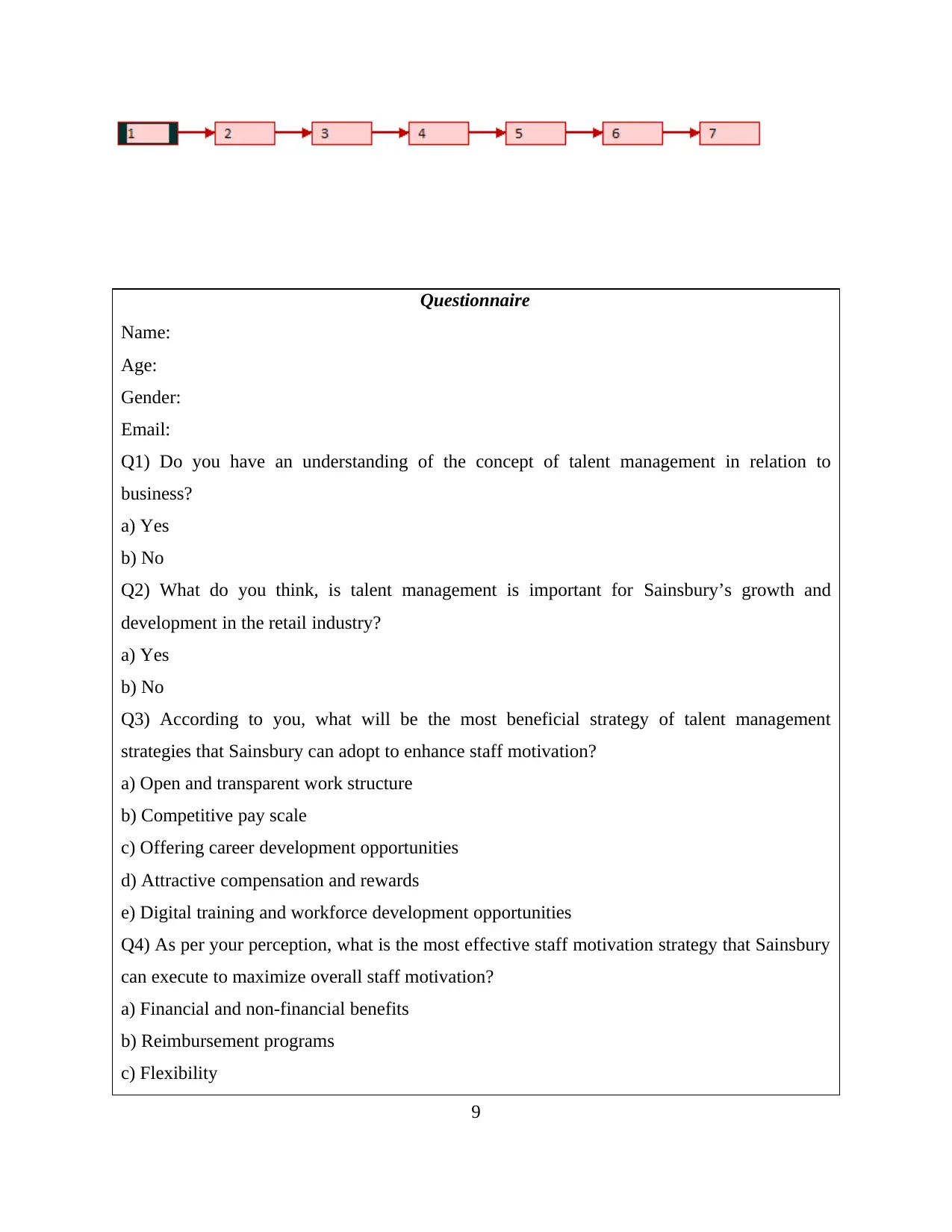
Questionnaire
Name:
Age:
Gender:
Email:
Q1) Do you have an understanding of the concept of talent management in relation to
business?
a) Yes
b) No
Q2) What do you think, is talent management is important for Sainsbury’s growth and
development in the retail industry?
a) Yes
b) No
Q3) According to you, what will be the most beneficial strategy of talent management
strategies that Sainsbury can adopt to enhance staff motivation?
a) Open and transparent work structure
b) Competitive pay scale
c) Offering career development opportunities
d) Attractive compensation and rewards
e) Digital training and workforce development opportunities
Q4) As per your perception, what is the most effective staff motivation strategy that Sainsbury
can execute to maximize overall staff motivation?
a) Financial and non-financial benefits
b) Reimbursement programs
c) Flexibility
9
Name:
Age:
Gender:
Email:
Q1) Do you have an understanding of the concept of talent management in relation to
business?
a) Yes
b) No
Q2) What do you think, is talent management is important for Sainsbury’s growth and
development in the retail industry?
a) Yes
b) No
Q3) According to you, what will be the most beneficial strategy of talent management
strategies that Sainsbury can adopt to enhance staff motivation?
a) Open and transparent work structure
b) Competitive pay scale
c) Offering career development opportunities
d) Attractive compensation and rewards
e) Digital training and workforce development opportunities
Q4) As per your perception, what is the most effective staff motivation strategy that Sainsbury
can execute to maximize overall staff motivation?
a) Financial and non-financial benefits
b) Reimbursement programs
c) Flexibility
9
⊘ This is a preview!⊘
Do you want full access?
Subscribe today to unlock all pages.

Trusted by 1+ million students worldwide
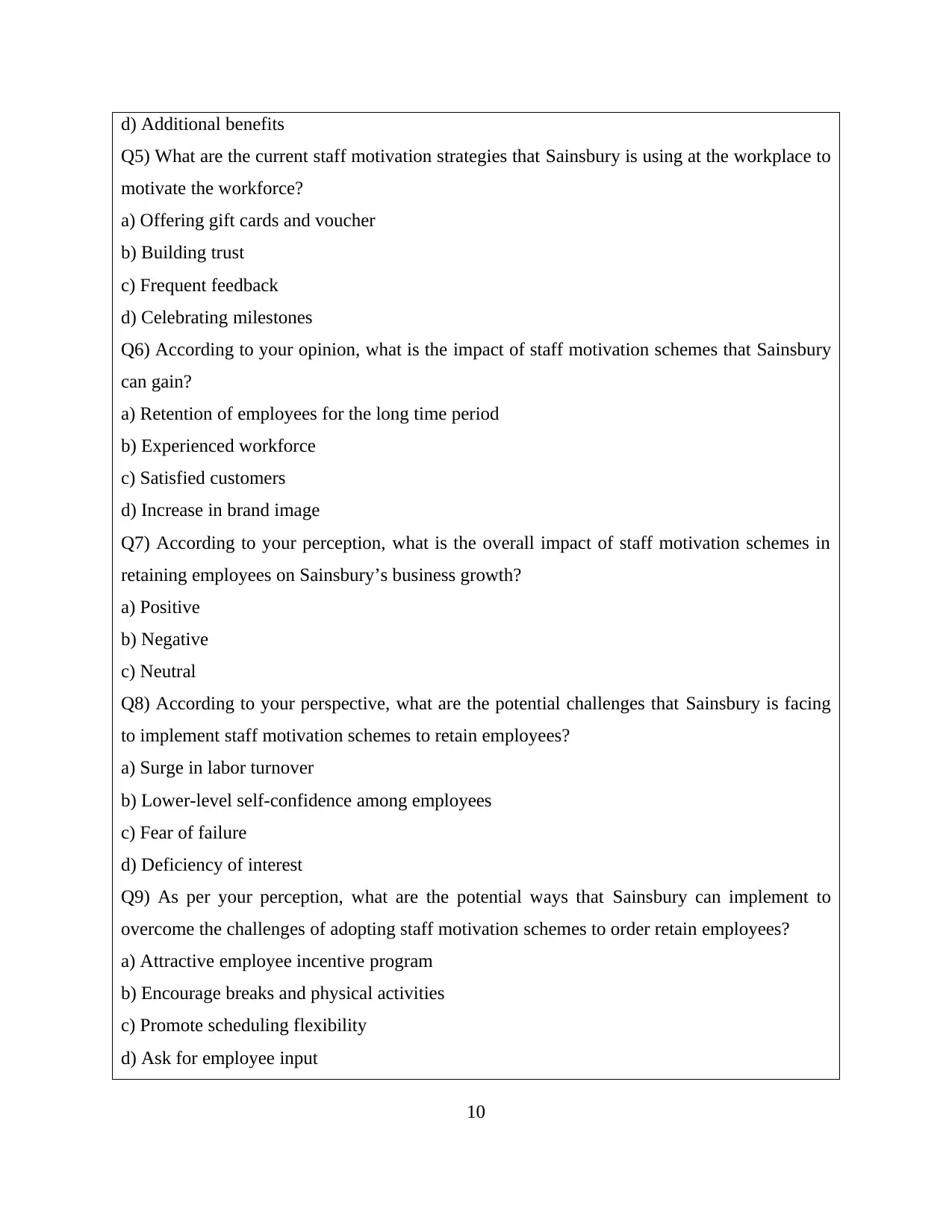
d) Additional benefits
Q5) What are the current staff motivation strategies that Sainsbury is using at the workplace to
motivate the workforce?
a) Offering gift cards and voucher
b) Building trust
c) Frequent feedback
d) Celebrating milestones
Q6) According to your opinion, what is the impact of staff motivation schemes that Sainsbury
can gain?
a) Retention of employees for the long time period
b) Experienced workforce
c) Satisfied customers
d) Increase in brand image
Q7) According to your perception, what is the overall impact of staff motivation schemes in
retaining employees on Sainsbury’s business growth?
a) Positive
b) Negative
c) Neutral
Q8) According to your perspective, what are the potential challenges that Sainsbury is facing
to implement staff motivation schemes to retain employees?
a) Surge in labor turnover
b) Lower-level self-confidence among employees
c) Fear of failure
d) Deficiency of interest
Q9) As per your perception, what are the potential ways that Sainsbury can implement to
overcome the challenges of adopting staff motivation schemes to order retain employees?
a) Attractive employee incentive program
b) Encourage breaks and physical activities
c) Promote scheduling flexibility
d) Ask for employee input
10
Q5) What are the current staff motivation strategies that Sainsbury is using at the workplace to
motivate the workforce?
a) Offering gift cards and voucher
b) Building trust
c) Frequent feedback
d) Celebrating milestones
Q6) According to your opinion, what is the impact of staff motivation schemes that Sainsbury
can gain?
a) Retention of employees for the long time period
b) Experienced workforce
c) Satisfied customers
d) Increase in brand image
Q7) According to your perception, what is the overall impact of staff motivation schemes in
retaining employees on Sainsbury’s business growth?
a) Positive
b) Negative
c) Neutral
Q8) According to your perspective, what are the potential challenges that Sainsbury is facing
to implement staff motivation schemes to retain employees?
a) Surge in labor turnover
b) Lower-level self-confidence among employees
c) Fear of failure
d) Deficiency of interest
Q9) As per your perception, what are the potential ways that Sainsbury can implement to
overcome the challenges of adopting staff motivation schemes to order retain employees?
a) Attractive employee incentive program
b) Encourage breaks and physical activities
c) Promote scheduling flexibility
d) Ask for employee input
10
Paraphrase This Document
Need a fresh take? Get an instant paraphrase of this document with our AI Paraphraser
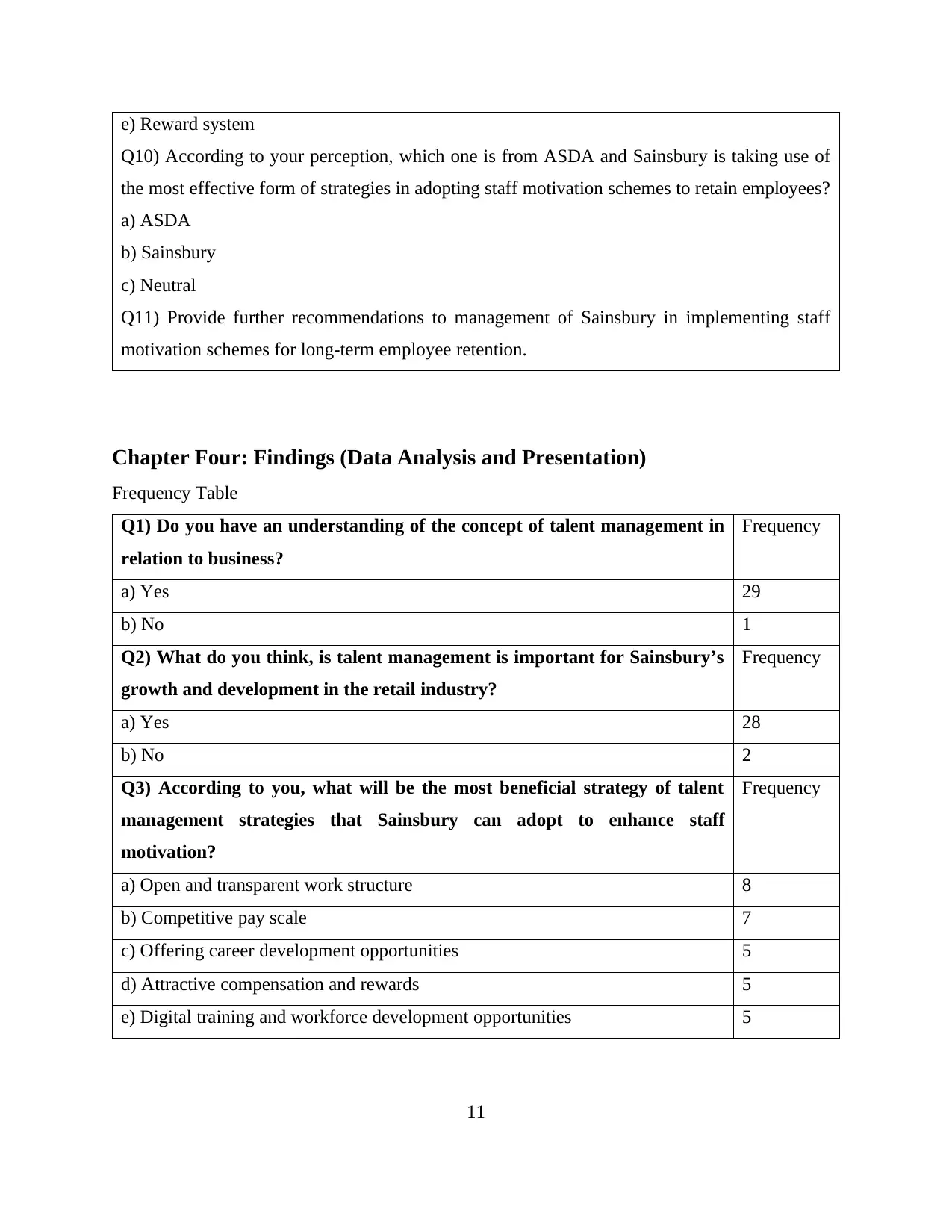
e) Reward system
Q10) According to your perception, which one is from ASDA and Sainsbury is taking use of
the most effective form of strategies in adopting staff motivation schemes to retain employees?
a) ASDA
b) Sainsbury
c) Neutral
Q11) Provide further recommendations to management of Sainsbury in implementing staff
motivation schemes for long-term employee retention.
Chapter Four: Findings (Data Analysis and Presentation)
Frequency Table
Q1) Do you have an understanding of the concept of talent management in
relation to business?
Frequency
a) Yes 29
b) No 1
Q2) What do you think, is talent management is important for Sainsbury’s
growth and development in the retail industry?
Frequency
a) Yes 28
b) No 2
Q3) According to you, what will be the most beneficial strategy of talent
management strategies that Sainsbury can adopt to enhance staff
motivation?
Frequency
a) Open and transparent work structure 8
b) Competitive pay scale 7
c) Offering career development opportunities 5
d) Attractive compensation and rewards 5
e) Digital training and workforce development opportunities 5
11
Q10) According to your perception, which one is from ASDA and Sainsbury is taking use of
the most effective form of strategies in adopting staff motivation schemes to retain employees?
a) ASDA
b) Sainsbury
c) Neutral
Q11) Provide further recommendations to management of Sainsbury in implementing staff
motivation schemes for long-term employee retention.
Chapter Four: Findings (Data Analysis and Presentation)
Frequency Table
Q1) Do you have an understanding of the concept of talent management in
relation to business?
Frequency
a) Yes 29
b) No 1
Q2) What do you think, is talent management is important for Sainsbury’s
growth and development in the retail industry?
Frequency
a) Yes 28
b) No 2
Q3) According to you, what will be the most beneficial strategy of talent
management strategies that Sainsbury can adopt to enhance staff
motivation?
Frequency
a) Open and transparent work structure 8
b) Competitive pay scale 7
c) Offering career development opportunities 5
d) Attractive compensation and rewards 5
e) Digital training and workforce development opportunities 5
11
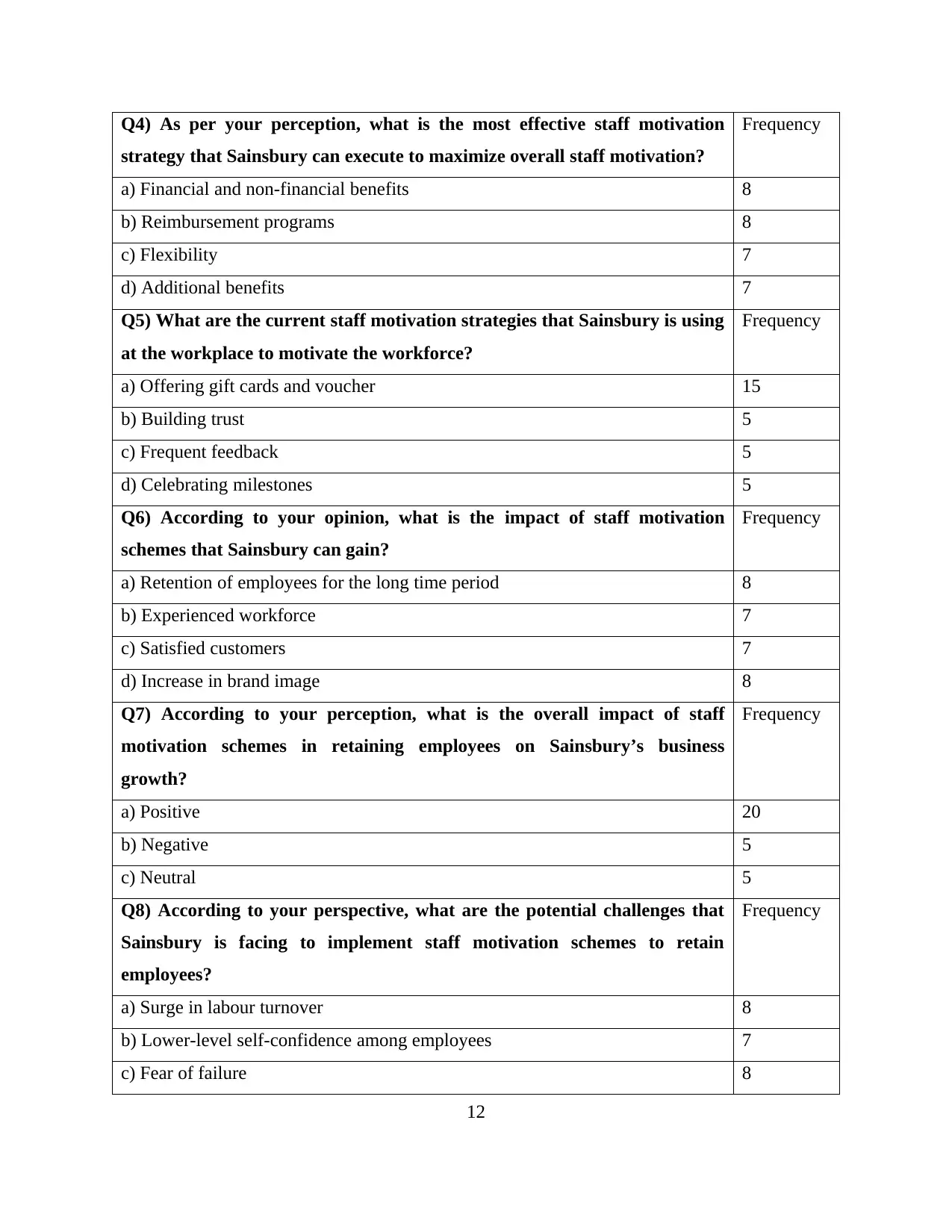
Q4) As per your perception, what is the most effective staff motivation
strategy that Sainsbury can execute to maximize overall staff motivation?
Frequency
a) Financial and non-financial benefits 8
b) Reimbursement programs 8
c) Flexibility 7
d) Additional benefits 7
Q5) What are the current staff motivation strategies that Sainsbury is using
at the workplace to motivate the workforce?
Frequency
a) Offering gift cards and voucher 15
b) Building trust 5
c) Frequent feedback 5
d) Celebrating milestones 5
Q6) According to your opinion, what is the impact of staff motivation
schemes that Sainsbury can gain?
Frequency
a) Retention of employees for the long time period 8
b) Experienced workforce 7
c) Satisfied customers 7
d) Increase in brand image 8
Q7) According to your perception, what is the overall impact of staff
motivation schemes in retaining employees on Sainsbury’s business
growth?
Frequency
a) Positive 20
b) Negative 5
c) Neutral 5
Q8) According to your perspective, what are the potential challenges that
Sainsbury is facing to implement staff motivation schemes to retain
employees?
Frequency
a) Surge in labour turnover 8
b) Lower-level self-confidence among employees 7
c) Fear of failure 8
12
strategy that Sainsbury can execute to maximize overall staff motivation?
Frequency
a) Financial and non-financial benefits 8
b) Reimbursement programs 8
c) Flexibility 7
d) Additional benefits 7
Q5) What are the current staff motivation strategies that Sainsbury is using
at the workplace to motivate the workforce?
Frequency
a) Offering gift cards and voucher 15
b) Building trust 5
c) Frequent feedback 5
d) Celebrating milestones 5
Q6) According to your opinion, what is the impact of staff motivation
schemes that Sainsbury can gain?
Frequency
a) Retention of employees for the long time period 8
b) Experienced workforce 7
c) Satisfied customers 7
d) Increase in brand image 8
Q7) According to your perception, what is the overall impact of staff
motivation schemes in retaining employees on Sainsbury’s business
growth?
Frequency
a) Positive 20
b) Negative 5
c) Neutral 5
Q8) According to your perspective, what are the potential challenges that
Sainsbury is facing to implement staff motivation schemes to retain
employees?
Frequency
a) Surge in labour turnover 8
b) Lower-level self-confidence among employees 7
c) Fear of failure 8
12
⊘ This is a preview!⊘
Do you want full access?
Subscribe today to unlock all pages.

Trusted by 1+ million students worldwide
1 out of 29
Related Documents
Your All-in-One AI-Powered Toolkit for Academic Success.
+13062052269
info@desklib.com
Available 24*7 on WhatsApp / Email
![[object Object]](/_next/static/media/star-bottom.7253800d.svg)
Unlock your academic potential
Copyright © 2020–2025 A2Z Services. All Rights Reserved. Developed and managed by ZUCOL.




